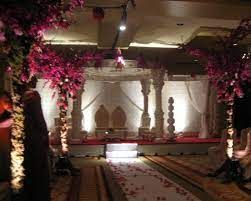
Jainism is one of the oldest religions in continuous practice today. Jain wedding traditions vary from sect to sect, but the weddings themselves have the same purpose: to bring together two families to celebrate the union of the bride and groom.
Pre-Wedding Traditions
There are a number of pre-wedding traditions that are observed. The first is Khol Barana, where the family of the groom comes to the bride’s home and gifts her with a silver plate, a coconut, and some cash. This is followed by the tilak ceremony, where the bride’s family visits the groom to bring him gifts.
Lagna Lekhan
The Lagna Lekhan is the first ritual to take place before the wedding. In a small ceremony called a puja at the bride’s home, which includes the bride and her family and friends, a pandit, or religious leader, chooses an auspicious date and time for the couple’s wedding.
Lagna Patrika Vachan
Once the date is chosen, the pandit will draft a letter containing the date and time of the wedding and send it to the groom’s home. The letter will be opened after a small puja and read aloud to the groom’s family and friends.
Sagai
The sagai is the engagement ceremony in Jainism. The bride’s family goes to the groom’s home, where her brother will gift the groom with clothes, jewelry, or money. The bride’s brother also performs a tilak puja on the groom, where he puts a tika on the groom’s forehead.
Mehndi
A few days before the wedding, the bride will gather her family and friends so they can apply henna paste in intricate designs on their hands and forearms. There are some designs particular to Jainism that are applied so the bride will have an advantageous marriage.
Bana Betai
The bride and groom are blessed with besan — chickpea flour paste — by the married women in their families on the day before their wedding day. They then take a ritualistic bath. The clothes they were wearing are donated to those in need.
Barati
The groom makes his way to the wedding ceremony on horseback. The barati is the formal acceptance of the groom by the bride’s family. The groom and the bride’s brother exchange coconuts. The brother also gives the groom even more gifts of sweet treats, clothing, and money. The bride’s mother and other married female relatives then sing a traditional folk song.
Kanyavaran
The bride is then brought to the wedding ceremony, and she’s given away by her parents. They place her hand, in which she holds a rupee, 25 paise, and some rice, in the groom’s hand. The bride’s father announces that his daughter is being married to the groom. The pandit pours water over the happy couple’s hands three times while reciting mantras.
Pheras
The couple circles the sacred flame four times, with the bride in the lead the first time, and the groom leading the other three times. The pandit recites the Mahaveerashtak Strot, and the wedding guests sing the Mangal Geets.
Wedding Vows
There are seven wedding vows at Jain weddings.
- To provide a home with a healthy diet
- To develop their own and each other’s physical and spiritual prowess
- To grow their wealth
- To acquire happiness through mutual love
- To have noble, virtuous children
- To work for the benefit of their family, extended families, and community
- To grow to become true helpmates
Post-Wedding Rituals
The first post-wedding ritual is receiving blessings from the elders of both families. Then the bride leaves her natal home and moves into the groom’s, where his family welcomes her. During the jina grahe dhan arpana, the couple visits a Jain temple with their families and gives alms to the poor.
Jain weddings are cloaked in ritual and ceremony. These beautiful pujas serve to remind the happy couple that they are part of something bigger than themselves — a family, a community, and a faith.
Add Your Comment